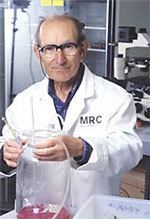Nationality British Name Robin Coombs | Fields Immunology | |
 | ||
Born 9 January 1921London, England ( 1921-01-09 ) Died January 25, 2006, Cambridge Notable awards Gairdner Foundation International Award (1965) Awards Gairdner Foundation International Award | ||
Robert Royston Amos ("Robin") Coombs (9 January 1921 – 25 January 2006), was a British immunologist, co-discoverer of the Coombs test (1945) used for detecting antibodies in various clinical scenarios, such as Rh disease and blood transfusion.
Contents
Biography
He was born in London and studied veterinary medicine at Edinburgh University. In 1943 he went up to King's College, Cambridge, where he commenced work on a doctorate, which he gained in 1947. Before finishing his doctorate, he developed and published methods to detect antibodies with Dr. Arthur Mourant and Dr. Rob Race in 1945. This is the test now referred to as the Coombs test, which, according to the legend, was first devised while Coombs was travelling on the train.
Coombs became a professor and researcher at the Department of Pathology of University of Cambridge, becoming a Fellow of Corpus Christi College, and a founder of its Division of Immunology. He was appointed the fourth Quick Professor of Biology in 1966 and continued to work at Cambridge University until 1988
In November 1956, Coombs founded the British Society for Immunology alongside John H. Humphrey, Bob White, and Avrion Mitchison.
He received honorary doctoral degrees by the University of Guelph, Canada, and the University of Edinburgh, Scotland and was a Fellow of the Royal Society of the United Kingdom (1965), a Fellow of the Royal College of Pathologists and an Honorary Fellow of the Royal College of Physicians.
Coombs was married to Anne Blomfield, his first graduate student. They had a son and a daughter.
Works
The Coombs test, which he developed and published together with Dr Arthur Mourant and Dr Rob Race in 1945, has formed the base of a large number of laboratory investigations in the fields of hematology and immunology.
Together with Professor Philip George Howthern Gell, he developed a classification of immune mechanisms of tissue injury, now known as the "Gell–Coombs classification", comprising four types of reactions.
Together with W.E. Parish and A.F. Wells he put forward an explanation of sudden infant death syndrome (SIDS) as an anaphylactic reaction to dairy proteins.
